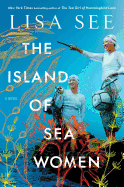
| Publisher: | Scribner | |
| Genre: | Women, General, Literary, Asian American, Fiction, Historical | |
| ISBN: | 9781501154850 | |
| Pub Date: | March 2019 | |
| Price: | $27 |
| Fiction |
by Lisa See
For centuries, the women of Jeju, an island off the south coast of Korea, made their living as haenyeo, deep-sea divers. Working in small groups, they trained from their youth to harvest the "sea-fields" and provide food and income for their families, while their husbands remained at home. Lisa See (China Dolls, The Tea Girl of Hummingbird Lane) explores the effects of political upheaval and massive technological changes in the 20th century on the haenyeo in her seventh historical novel, The Island of Sea Women.
See begins her narrative in the 1930s, as two young girls, Kim Young-sook and Han Mi-ja, begin their training as haenyeo. Young-sook is the daughter of the local diving chief, Mi-ja the neglected child of a Japanese collaborator. But the girls become friends and learn the skills of diving together, navigating the physical strain and emotional losses of their work. Their story continues through their years of diving, marriage and motherhood, as World War II and other conflicts bring new politics, new technologies and new ideas to their island.
See uses brief flash-forward scenes set in 2008, when Young-sook is an old woman, to hint at a longstanding break between the two friends. Gradually, the two narratives bend toward one another, revealing the layers of Young-sook's grief and the incident that ended her friendship with Mi-ja. Along the way, See paints a vivid portrait of family life on Jeju, charts the atrocities the islanders experienced under Japanese occupation and asks whether forgiveness is possible, for people and for communities.
Meticulously researched and rendered in Young-sook's compelling voice, See's novel is a fascinating glimpse into a little-known culture and a powerful exploration of loss and healing. --Katie Noah Gibson, blogger at Cakes, Tea and Dreams

| Publisher: | Graywolf Press | |
| Genre: | Drama, American, African American | |
| ISBN: | 9781555978396 | |
| Pub Date: | March 2019 | |
| Price: | $16 |
| Fiction |
by Claudia Rankine
Claudia Rankine is, among other things, a poet best known for the National Book Critics Circle Award-winning Citizen: An American Lyric. The White Card is her first published play, a one-act drama composed of two scenes. The first is set at a dinner party hosted by Virginia and Charles, a philanthropist and art collector. The guest of honor is Charlotte, an up-and-coming black artist whom Charles wants to feature.
The play approaches the difficult reality of people who "read all the relevant books on racism, see all the documentaries and films... but in the moment of dialogue or confrontation retreat into a space of defensiveness, anger, silence, which is to say he might retreat into the comfort of control...." As the evening progresses, Charlotte and the couple's young, activist son, Alex, critique Charles's white-savior position in the art world, pushing him out of his comfort zone until he retreats to a reflexive, defensive posture.
The second scene continues Charles and Charlotte's conversation one year later, in her studio. Tensions heighten as Charlotte attempts to make him see himself as part of the ongoing tragedy of race in the United States rather than a separate, impartial observer.
The White Card stands out due to the realism of its discourse. It manages to be a provocative work without straw-manning other perspectives. When Charles says, "I truly am trying to find a way through," it's easy to believe him. The play also documents Charlotte's changing answer to the question: "What does it mean to portray black suffering as art?" The White Card stages difficult conversations around race, art and guilt that are too frequently avoided. --Hank Stephenson, bookseller, Flyleaf Books, Chapel Hill, N.C.

| Publisher: | Catalyst Press | |
| Genre: | Cultural Heritage, Family Life, General, Coming of Age, Literary, Fiction | |
| ISBN: | 9781946395108 | |
| Pub Date: | February 2019 | |
| Price: | $15 |
| Fiction |
by Yewande Omotoso
Through three decades, two countries and multiple points of view, a complete picture of Leke's life in the present slowly surfaces in Yewande Omotoso's debut novel. Shortlisted for the 2012 Sunday Times Fiction Prize, Bom Boy is published in North America for the first time following the critical acclaim for her second novel, The Woman Next Door, a 2018 finalist for the International Dublin Literary Award and a nominee for the Hurston/Wright Legacy Award for Fiction.
Leke lives between worlds: Nigerian and South African, white and black, birth family and adoptive family, dreaming and awake. He struggles to make connections with people and between what's real and what's imagined. Pieces of his story fall into place when his adoptive father hands him letters written by his birth father. At first, Leke ignores them entirely. His day-to-day behavior becomes increasingly erratic. He pickpockets and shoplifts small objects and begins innocently stalking people out of curiosity. Over time he becomes a hypochondriac in an attempt to discover the cure for his heartbreaking loneliness and isolation.
It is only by taking the risk genuinely to connect with someone in his present that Leke is able to face the past contained in the letters, and he learns his only hope is to break the curse placed upon his family generations before. Despite his quirks, Leke's plight is curiously engaging as it speaks to the universal yearning to belong somewhere with someone. --BrocheAroe Fabian, owner, River Dog Book Co., Beaver Dam, Wis.

| Publisher: | Algonquin | |
| Genre: | Friendship, General, Literary, Fiction, LGBT | |
| ISBN: | 9781616207588 | |
| Pub Date: | March 2019 | |
| Price: | $26.95 |
| Starred | Fiction |
by Mathangi Subramanian
In her poetic first novel for adults, A People's History of Heaven, Indian American author Mathangi Subramanian (Dear Mrs. Naidu) imagines the lives of five teen girls in a Bangalore slum on the brink of destruction.
"Heaven" takes its name from the Sanskrit words on a nearby sign, though the "ragged jigsaw of tilted tents, angry quilt of rusted roofs, maze of sagging sofas" make the ramshackle neighborhood look anything but celestial. In fact, the government has sent a demolition crew to tear down Heaven so they can replace it with a new shopping center. The residents, mostly abandoned wives raising a vibrant assortment of daughters with few prospects, band together to stop the bulldozers.
The first-person-plural narrative voice, speaking from the girls' point of view, opens the story with a scene of the women forming a human chain, predicting, "Our houses may break, but our mothers won't." Leaving the reader with that potent image, the voice relates a chronologically fluid history of the hilarity and heartache the girls have faced together over the years.
In this Heaven, love comes first. Subramanian, who lives in New Delhi, never shrinks from the dangers and discrimination facing impoverished women, but she also gives her characters resiliency and hope in the form of each other. Rich imagery conjures up the bustle of a diverse city where children live in poverty mere blocks from three-story homes where their mothers work as maids. With its heroic young cast, A People's History of Heaven has huge YA crossover potential, and its social commentary makes it a wonderful book club selection. --Jaclyn Fulwood, blogger at Infinite Reads

| Publisher: | Minotaur | |
| Genre: | Police Procedural, Mystery & Detective, International Crime & Mystery, Fiction | |
| ISBN: | 9781250298287 | |
| Pub Date: | February 2019 | |
| Price: | $27.99 |
| Mystery & Thriller |
by Ausma Zehanat Khan
In the midst of investigating a mass shooting at a Québécois mosque, Detective Rachel Getty finds herself reflecting on something her partner, Detective Esa Khattak, once said of a previous case: "How quickly the violent ideals of ultra-nationalism led to hate, how quickly hate to blood." Though he's referring to the case central to The Unquiet Dead (the first Ausma Zehanat Khan novel to feature the detective pair), the theme is one that threads through each of the Khattak and Getty mysteries. In earlier books in the series, Khan has explored war crimes, genocide and refugees; in A Deadly Divide, the fifth in the series, she turns her attention to domestic terrorism and anti-Muslim sentiments.
The novel centers on the heartbreaking and devastating story of the mosque shooting, the latest in a string of anti-Islam actions in a small town in Quebec. The subject itself is ripped from the headlines--Khan writes in an author's note about the actual January 2017 shooting--but the similarities to typical news media stop there. A Deadly Divide does not offer a glancing look at hate, used solely as a vehicle by which to move the plot of a novel forward; instead, like Khan's past books, the subject is the starting point for a deeper dive into animosity in its many forms. In a fast-paced and expertly plotted mystery, Khan explores the depths of human complexity and the very human costs of hate. --Kerry McHugh, blogger at Entomology of a Bookworm
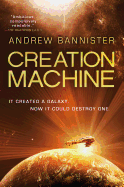
| Publisher: | Tor | |
| Genre: | Space Opera, Space Exploration, Hard Science Fiction, Fiction, Action & Adventure, Science Fiction | |
| ISBN: | 9781250179135 | |
| Pub Date: | March 2019 | |
| Price: | $16.99 |
| Science Fiction & Fantasy |
by Andrew Bannister
In an isolated mini-galaxy called the Spin, everything is artificial. As natural as its suns and planets seem, each atom was placed with purpose by ancient unknown builders. The Spin is a rough neighborhood, from the expanding high-tech Hegemony dominating the Outer Spin to the horrific little lower-tech empires that periodically plague the Inner Spin. Every once in a while, someone discovers an artifact belonging to the architects, and causes chaos.
Fleare Haas is the only daughter of Viklun Haas, ultra-rich industrialist and a major player in the Hegemony. After a childhood spent watching her father scheme and exploit his way to the top, she harbors a bit of a rebellious streak. Fleare's flirtation with a recently destroyed rebel group finds her imprisoned in an odd monastery. When she is rescued by an old lover/comrade, now transformed into a cloud of nanomachines, she gets caught up in dangerous tides of shifting and shifty interests. Meanwhile, an aristocrat in an empire of pillaged worlds called the Fortunate Protectorate plots how best to use a potentially powerful artifact, pitting the barbaric Inner Spin against everyone else.
Creation Machine is Andrew Bannister's debut novel and the first entry in the Spin trilogy. Bannister combines succinct world-building with impulsive readability and likable characters. Creation Machine finds frequent parallels with the best of Iain M. Banks's Culture series. Perhaps the novel's greatest flaw is that it isn't longer. Thankfully, the second book in the Spin trilogy, Iron Gods, is projected for July 2019. --Tobias Mutter, freelance reviewer
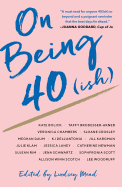
| Publisher: | Simon & Schuster | |
| Genre: | Biography & Autobiography, Women, Women Authors, Literary Collections, Essays | |
| ISBN: | 9781501172120 | |
| Pub Date: | February 2019 | |
| Price: | $26 |
| Starred | Biography & Memoir |
by Lindsey Mead, editor
In On Being 40(ish), 15 women muse on what being 40 years old--give or take--means in their lives. This anthology, edited by freelance writer Lindsey Mead, offers diverse viewpoints and concerns but as a whole aims to inspire. As Mead writes in her introduction, "These are not reflections on the dying of the light, but rather a full-throated celebration of what it means to be an adult woman at this moment in history."
The contents are varied, including celebrations, uncertainties and elegies. Some writers mourn losses, some rejoice at new beginnings; some are concerned with the existential, some more lightheartedly concerned with changing appearances. Lee Woodruff writes about her mother's 40th birthday, her own and what she hopes to pass down to her own daughters. Taffy Brodesser-Akner writes about time, which "happens no matter what you're doing with it." The quickness with which years pass is a theme across these essays, as is the victory involved in aging: "by forty, we know who we are," Jill Kargman writes. "When we are young, we are diluted versions of ourselves. We become balsamic reductions as we age--our very best parts distilled and clarified."
Allison Winn Scotch writes about accepting the unexpected when a devastating injury interrupts plans for a trip to Mexico. She closes: "I worried that my injury would upend everything. It turns out that it did." And that's a happy ending.
On Being 40(ish) is mostly about happy endings; or the ongoingness of life--its not ending at all, not yet. This is an anthology for women of all ages and all perspectives. --Julia Kastner, librarian and blogger at pagesofjulia
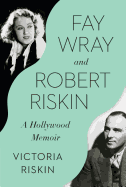
| Publisher: | Pantheon | |
| Genre: | Biography & Autobiography, Rich & Famous, Personal Memoirs, Entertainment & Performing Arts | |
| ISBN: | 9781524747282 | |
| Pub Date: | February 2019 | |
| Price: | $30 |
| Biography & Memoir |
by Victoria Riskin
Being the child of a famous actress has its perks. Among its downsides are fielding questions like, "Hey, is your dad an ape or something?"
Victoria Riskin is the daughter of Fay Wray (1907-2004), who famously dangled from the hand of King Kong in the 1933 classic film, and the screenwriter Robert Riskin (1897-1955), whose scripts included the 1934 screwball comedy standard-bearer It Happened One Night. That Wray and Riskin don't become a couple until 100-odd pages from the end of Fay Wray and Robert Riskin: A Hollywood Memoir reflects two things: how relatively short their relationship was--they hadn't been together a decade when he suffered a permanently debilitating stroke--and how interesting their lives were before they married.
Fay Wray and Robert Riskin belongs on a shelf beside Margaret Talbot's The Entertainer: both odes to famous parents double as histories of the American film industry. Riskin's scrupulously researched book--which leans on family artifacts, her mother's autobiography and a galaxy of archival photographs--covers subjects including how writers' unions evolved to the tyranny of gossip columnists and Hollywood's (and especially Robert Riskin's) contribution to the war effort.
Because the author was nine when her father died, only a small chunk of the book fulfills the promise of its subtitle. Before their father's illness, Riskin and her siblings lived in a Bel Air home where Harpo Marx was a regular guest and Cary Grant lived within walking distance. When Riskin writes, "Our childhoods were idyllic," she doesn't mean dull. --Nell Beram, author and freelance writer
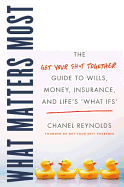
| Publisher: | Harper Wave | |
| Genre: | Self-Help, Family & Relationships, Biography & Autobiography, Death, Grief, Bereavement, Psychology, Personal Memoirs, General | |
| ISBN: | 9780062689436 | |
| Pub Date: | March 2019 | |
| Price: | $25.99 |
| Psychology & Self-Help |
by Chanel Reynolds
The unthinkable happened to Chanel Reynolds in July 2009: her husband, José, 44, was struck by a van while riding his bicycle in their hometown of Seattle, Wash. It took a week for him to die--hooked up to life support. Reynolds states, "I did not choose for him to die but I had to choose to let him go."
In What Matters Most, Reynolds's first book, she shares the intimate story of her husband's accident, her struggle to make critical life-and-death decisions and how those decisions affected her along with their young son, Gabi, and José's daughter, Lyric, from a prior marriage.
Reynolds faced an onslaught of red tape--everything from dealing with mortgage and car payments, deciphering bank accounts, and understanding life insurance and wills to figuring out next steps for her and the kids. Reynolds was forced to learn things the hard way. This led her, three years later, to launch a website called Get Your Sh*t Together, aimed at helping others avoid unpreparedness.
Her book compiles work from her website and shares her extensive research through surveys, conversations with experts and hearing the stories of thousands of people across the country who have taken her workshops. Reynolds is not a financial or legal adviser. However, her story, told from the trenches of life, is powerful and wise. Her message--sort out your finances and get your end-of-life wishes in order before it's too late--offers readers a generous opportunity to learn from her experiences and be more fully prepared. --Kathleen Gerard, blogger at Reading Between the Lines
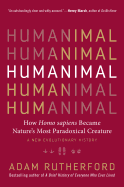
| Publisher: | The Experiment | |
| Genre: | Life Sciences, Genealogy & Heraldry, Genetics & Genomics, Reference, Science, Anthropology, Cultural & Social, Social Science | |
| ISBN: | 9781615195312 | |
| Pub Date: | March 2019 | |
| Price: | $25.95 |
| Nature & Environment |
by Adam Rutherford
All living creatures--bedbugs and bonobos, yeast and yellowjackets, hedgehogs and humans--have much in common. We all descend from a single point of origin, share DNA and evolve through natural selection. But about 40,000 years ago, humans took a "Great Leap Forward" and achieved a level of sophistication not found in other animals. Humans are special, but are we unique?
In Humanimal, science writer Adam Rutherford (A Brief History of Everyone Who Ever Lived) considers the behaviors that Homo sapiens share with animals, and those that are different, to help us understand our own evolution. For example, many animals use tools, such as the firehawk, which picks smoldering sticks from brush fires to create new fires and feast on escaping creatures. Yet no other animal has the brain capacity or dexterity to create tools like humans. While it's a given that humans have sex for pleasure and procreation, Rutherford is reluctant to affix human sexual emotions onto animals. But many species also engage in sexual activity without the intent to procreate. Homosexuality is also prevalent in the animal kingdom, as are sexual behaviors like masturbation and fellatio, behaviors we often ascribe only to humans.
So, what makes humans distinct? Many animals communicate and share the ancient gene FOXP2, but only in humans did the right combination of FOXP2 and other genes yield speech. Rutherford theorizes that the human population explosion during the Great Leap Forward allowed for the transmission of skills. While many animals are capable of learning, it's only humans who teach, leading to the development of culture that sets us apart. --Frank Brasile, librarian
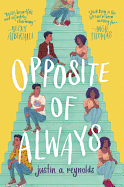
| Publisher: | Katherine Tegen Books/HarperCollins | |
| Genre: | Humorous, Romance, Contemporary, General, Time Travel, Young Adult Fiction, Science Fiction | |
| ISBN: | 9780062748379 | |
| Pub Date: | March 2019 | |
| Price: | $17.99 |
| Children's & Young Adult |
by Justin A. Reynolds
Jack Ellison King is, in his words, "an authority on Almost." "You name it," his first-person narration states, "I've found a way to miss my chance." It's ironic, then, that the self-proclaimed "Jack of all. King of none" is named after trailblazers Jackie Robinson and Ralph Ellison.
It's senior year and Jack is in love with his best friend, Jillian. Unfortunately, her boyfriend, Franny, is Jack's "other best friend." Jack loves them both and "would never consider doing anything to jeopardize their relationship." But he never really stops thinking about Jillian and his habit of "missing out." Thus, when he meets a girl at a Whittier College party, he decides to go for it--he will actively pursue the funny, interesting, mysterious, college-freshman Kate. Though they quickly fall for each other, Kate keeps Jack at arms-length. She finally explains this distance to him while literally on her deathbed: she is "genetically unwell" and is consequently fearful of romantic entanglements. Immediately after this conversation, she dies. Soon after, surprisingly, Jack dies, too: "a shrill of feedback blasts between my ears and I know this is the end.... Good night." --And then, Jack is at the Whittier College party again, meeting Kate for the first time....
Groundhog Day-style, Jack begins to live his senior year over and over, always resetting when Kate dies. Reynolds builds a world that changes realistically with each iteration, always showing how Jack's actions affect others. Relationships take a central role in this passionate novel, as Reynolds delves into the emotional experience of Jack's inner circle, giving them and their interpersonal connections depth. It's an intense ride and readers are likely going to want to stick with Jack to the (real) end. --Siân Gaetano, children's and YA editor, Shelf Awareness
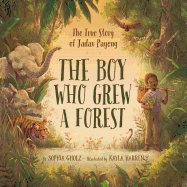
| Publisher: | Sleeping Bear Press | |
| Genre: | Biography & Autobiography, People & Places, Asia, Trees & Forests, Science & Nature, Cultural, Ethnic & Regional, Juvenile Nonfiction | |
| ISBN: | 9781534110243 | |
| Pub Date: | March 2019 | |
| Price: | $16.99 |
| Starred | Children's & Young Adult |
by Sophia Gholz, illust. by Kayla Harren
Debut author Sophia Gholz tells the inspiring story of Jadav "Molai" Payeng, a boy from a "large river island" in India, whose passion for nature inspired him to rebuild his home's ecosystem.
Distraught by damage caused by floodwaters, Jadav consulted with village elders. They "explained [to him] that the only way to help animals was to create new homes for them," so they gave him 20 bamboo saplings, unknowingly setting him off on a lifelong conservation effort. He planted the seedlings, engineered an irrigation system and enriched the soil by carrying "cow dung, earthworms, termites, and angry red ants that bit him" to his thicket. As Jadav and his trees grew and prospered, he planted more. Over time, the wildlife returned: "buffalo, one-horned rhinos, and snakes, gibbons, migratory birds, and elephants." Jadav used his ingenuity to overcome each new challenge and nurture his growing forest.
Gholz's respect for Jadav's accomplishments shines through in her endearing presentation of his life. The book's back matter adds biographical details, word definitions and directions on how to "Plant a Forest of Your Own." And while readers learn Jadav was actually a teenager when he started his forest, the younger depiction of him at the start of the book allows the intended four- to eight-year-old audience better to relate to him. Accompanying Gholz's uplifting tale are stunning illustrations by Kayla Harren (Hannah's Tall Order). The bold colors and distinct textures of Jadav's island home are so realistic, one almost expects to hear an elephant trumpet or a gibbon sing. The Boy Who Grew a Forest celebrates an incredible man and arouses in its audience a respect for nature that may motivate them to follow in Jadav's footsteps. Superb. --Jen Forbus, freelancer